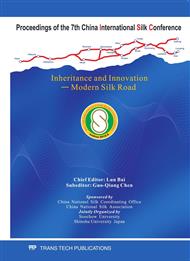p.143
p.149
p.153
p.158
p.164
p.170
p.176
p.181
p.186
Pre-Oxidation Nanofibers from Acrylonitrile-Acrylamide Copolymers Synthesized by Solvent-Water Polymerization
Abstract:
Solvent-water suspension free-radical polymerization method was used to synthesize acrylonitrile(AN)-acrylamide(AM) copolymers in this paper. The copolymerization was carried out with azobisisobutyronitrile (AIBN) as an initiator and dimethysulfoxide (DMSO)/ water solution as solvents at a constant monomer ratio (AN:AM(wt)=85:15). The ratio(wt) AN:AM=100:0 was also be used for a comparison. The structure and properties of the copolymers was studied by fourier transform infrared (FT-IR), X-ray diffraction (XRD) and thermogravimetry(TG). The nanofibers were obtained by electrospinning AN-AM copolymer solution with N,N-Dimethyl acetamide(DMAc) as a solvent. Then, the fibers were pre-oxidized in relaxation state and in air by using an oven. The structure of pre-oxidized nanofibers was investigated by scanning electron microscopy (SEM) and FT-IR. The results showed that the ratio of dimethysulfoxide (DMSO)/water 50/50(v) was optimum for the copolymer properties and nanofiber spinnability as a carbon nanofiber precursor. The copolymer fibers only needed lower preoxidation temperature and shorter preoxidation time to reach the same degree of cyclization due to the introduction of AM.
Info:
Periodical:
Pages:
164-169
Citation:
Online since:
January 2011
Authors:
Price:
Сopyright:
© 2011 Trans Tech Publications Ltd. All Rights Reserved
Share:
Citation:


